James Maliszewski's Blog, page 117
February 10, 2022
Burn, Witch, Burn!
 The wheels of publishing turn slowly. Nevertheless, the Centipede Press edition of the classic Abraham Merritt story, Burn, Witch, Burn! to which I contributed an introduction will be making its appearance sometime next month. Like all Centipede Press books, this will be limited edition of only a few hundred copies, but I have no doubt it'll be a gorgeous one. When I have more specific information to share about the book, I'll write another post about it.
The wheels of publishing turn slowly. Nevertheless, the Centipede Press edition of the classic Abraham Merritt story, Burn, Witch, Burn! to which I contributed an introduction will be making its appearance sometime next month. Like all Centipede Press books, this will be limited edition of only a few hundred copies, but I have no doubt it'll be a gorgeous one. When I have more specific information to share about the book, I'll write another post about it.
A Radical Proposal (Part II)
Knowledge
Willpower
Dexterity
Constitution
Acumen
February 9, 2022
Lost in a Forbidding Land
Here's a 1982 advertisement for Milton Bradley's electronic fantasy boardgame Dark Tower.

Retrospective: The Best of Dragon
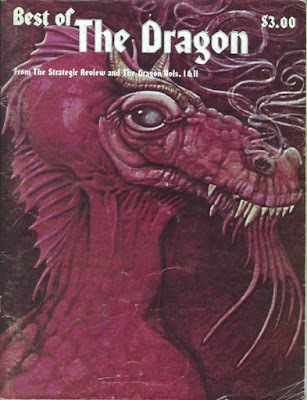 The first copy of Dragon I ever purchased was issue #62, which first appeared in June 1982, though I'd read a smattering of issues before this. I began subscribing to Dragon with issue #68 (December 1982) and maintained that subscription for the next five years (stopping only when I went away to college). Consequently, I largely missed out on the first five or six years of the periodical's run.
The first copy of Dragon I ever purchased was issue #62, which first appeared in June 1982, though I'd read a smattering of issues before this. I began subscribing to Dragon with issue #68 (December 1982) and maintained that subscription for the next five years (stopping only when I went away to college). Consequently, I largely missed out on the first five or six years of the periodical's run.I say "largely," because I had previously acquired two volumes of Best of (the) Dragon, which appeared in 1980 and 1981 and, through them, I got a small glimpse of the magazine's early days that would otherwise have been unknown to me. The first volume I bought while on vacation with my family; the second during Christmastime, probably from Waldenbooks, my usual purveyor of gaming magazines. For many years afterward, they were among my most prized gaming possessions and took them everywhere with me. It's a testament to my fastidiousness that I still have those very same copies today, not much worse for wear after more than four decades.
Of the two, Volume I was by far my favorite, if only because it was so strange – or so it seemed to me when I first set eyes on it. To begin, its cover, by John Barnes, is quite unlike the covers of Dragon with which I was already familiar, reminding me of some weird portrait one might find hanging on the wall of a reclusive eccentric. Having always been attracted to the weird, this was a point in the collection's favor and almost certainly contributed to my picking it up when I first laid eyes upon it.
The cover, though, wasn't the only thing I deemed weird at the time. The content, too, was unusual, featuring as it did a mishmash of content, some which made little immediate sense to me at the time. Take, for example, the plethora of articles about Metamorphosis Alpha. What was this game that seemed to be so much resemblance to my beloved Gamma World and yet was so obviously something else entirely? I'd read the name Metamorphosis Alpha before in both the Dungeon Masters Guide and Expedition to the Barrier Peaks, of course, but I never gave it much thought prior to reading these articles in Best of the Dragon, after which it became an obsession of sorts, as I feverishly sought, to no avail, to lay hands on a copy of this predecessor to Gamma World.
The weirdness didn't end there, though. Volume I was filled with what then seemed like oddities, such as James Ward's "Deserted Cities of Mars," Gary Gygax's "Sturmgeshutz and Sorcery," and strange variants of already existing AD&D classes, like the illusionist, ranger, and bard. At the time, I didn't realize that these articles were the original versions of these character classes, intended as additions to OD&D. Aside from the Holmes and Moldvay Basic Sets, I'd not yet seen anything directly connected to the 1974 version of the game and I was both baffled and fascinated by these articles. They lent the first volume an aura of mystery that kept me reading and re-reading its articles.
There were also plenty of articles I immediately appreciated and used in my games, like Lee Gold's "Languages" and "Demon Generation" by Jon Pickens. This was even more the case for Volume II, which contained a huge number of articles that piqued my interest, starting with all the so-called NPC classes. NPC classes were a staple of Dragon, even when I was regularly reading it. They occupied a peculiar place in the eyes of D&D players, since they weren't formally intended for use for players characters but everyone knew a referee who was lenient and allowed someone to play a samurai or berserker. Dragon, as the organ of TSR, pooh-poohed such behavior, of course, but these classes were very popular with readers and so they kept appearing.
Volume II included lots of other goodies that appealed to me, such as the articles on tesseracts, undead, poison, and, of course, "The Politics of Hell" by Alexander von Thorn. That last article left a very strong impression on me as a kid and forever colored my conception of devils in D&D, despite its very idiosyncratic take on the infernal regions. When I came to Toronto in the early '90s, I discovered, quite by accident, that one of the owners of the game store I frequented here was, in fact, the author of that article. Life can be strange!
Subsequent volumes of Best of Dragon never impressed me as much, because they covered time periods when I was a regular reader. I already had access to their contents, so why would I need them in anthologized form? Those first two volumes, though, were one of my earliest windows into the much more wild and woolly world of the hobby, one I'd missed by a couple of years and whose echoes, still occasionally heard even in the early 1980s, didn't always make sense to me. Best of Dragon filled in a few of the details, but what it really did was point me in the direction of seeking out more information about what had come before I started playing. I'm still very grateful for that.
February 8, 2022
White Dwarf: Issue #26
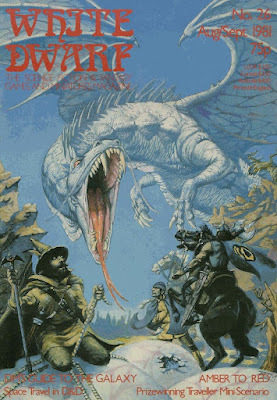 Issue #26 of White Dwarf (August/September 1981) features a cover by Ian McCaig, an artist well known for his contributions to movies and album covers. Ian Livingstone's editorial floats the idea of the White Dwarf's becoming a monthly periodical but also expresses concern that doing so might affect its overall quality. To ensure this doesn't happen, he needs more regular contributors, particularly for games like D&D, Traveller, and RuneQuest (three games I strongly associate with WD, particularly the latter two). It will be interesting, from a historical point of view, to see how soon his call for new writers has any effect on the magazine's content.
Issue #26 of White Dwarf (August/September 1981) features a cover by Ian McCaig, an artist well known for his contributions to movies and album covers. Ian Livingstone's editorial floats the idea of the White Dwarf's becoming a monthly periodical but also expresses concern that doing so might affect its overall quality. To ensure this doesn't happen, he needs more regular contributors, particularly for games like D&D, Traveller, and RuneQuest (three games I strongly associate with WD, particularly the latter two). It will be interesting, from a historical point of view, to see how soon his call for new writers has any effect on the magazine's content.
The issue kicks off with a remarkable article by Marcus L. Rowland entitled "The DM's Guide to the Galaxy." Subtitled "Space Travel in D&D," Rowland sketches out the broad outline of what space travel might look like in Dungeons & Dragons, drawing on existing rules for inspiration and insights into the nature of space in a universe where magic works. Having long been a fan of the concept of fantasy space travel, this article pleased me, though I wish it had been longer and more fully fleshed out.
"Open Box" tackles four new game products, starting with Games Workshop's own Apocalypse, a game previously entitled The Warlord, which involves the struggle between small empires in post-apocalyptic Europe. The reviewer gives the game a 9 out of 10, which may well be justified, but the fact that the review appears in a Games Workshop periodical makes me question his objectivity. Also reviewed are High Guard for Traveller (also 9 out of 10), Expedition to the Barrier Peaks (9 out of 10), and Knights of Camelot (a mere 7 out of 10).
Part II of Roger Musson's "The Dungeon Architect" focuses on the architectural features of a dungeon, starting with often forgotten elements like verticality and transit. Musson makes the very good point that dungeons exist in three dimensions; yet, many referees fail to take into account height and depth. Likewise, he draws attention to rapid means of getting in and out of the dungeon, such as teleport systems and the like. I find such considerations fascinating, since they're clearly reflective of an earlier, megadungeon-centric style of play that had already begun to fade by the time I entered the hobby. The logistics of a dungeon "expedition" were much less onerous in my youth, so it's good to be reminded of the way things were played before me. Musson rounds out the article with an examination of what he calls "vindictive" features, such as traps, one-way doors, etc.
"Jump Drive Problems" is a collection of short submissions on this topic for use with Traveller. They're a follow-up to the original article on this subject, which appeared in issue #24. Meanwhile, "Lizard Men as Player Characters" by Roger E. Moore and Michael Brown is exactly what its title suggests: providing guidelines for making this reptilian race available for players of AD&D (and even references Quag Keep in support of the idea). "Amber to Red" by Neil Cheyne is a Traveller scenario, the winner of a competition sponsored by the magazine. The scenario involves the hijacking of a starship, with the players taking the roles either of the hijackers or the defenders. It's a perfectly serviceable adventure, complete with starship deckplans, but nothing special in my opinion.
Part IV of Lewis Pulsipher's "An Introduction to Dungeons & Dragons" turns its attention to fighters and thieves. Pulsipher has a lot more to say about the latter than the former. He stresses the flexibility of the thief class and its many potential roles in a party. Frontline fighting, however, is not one of them and repeatedly emphasizes the need to "think thievishly" when playing the class – good advice. "Treasure Chest" continues to offer a grab-bag of new magic items, like the potion of quiet spell casting (which eliminates the need for a verbal component when imbibed) and the assassin's toolkit (filled with all manner of nasty aids to murder). Finally, "Fiend Factory" presents a collection of new humanoid monsters, like shadow goblins and winter kobolds. It's not the column's best installment, though its inclusion of proposed collective nouns for D&D monsters is fun (a confusion of umber hulks, a heard of ear seekers, and a fraction of halflings being some of the best ones).
Issue #26 is a solid, workmanlike effort – nothing special but nevertheless filled with entertaining and occasionally thought-provoking material. As I keep saying in these posts, White Dwarf is inching ever closer to resembling the magazine I remember from my youth (which isn't surprising, since my first issue was #32). It's a worthy alternative to Dragon, both in terms of its focus and, more importantly, perspective.
February 7, 2022
A Radical Proposal
My idea, partly inspired by Basic Role-Playing, is that a newly generated character starts the campaign with a number of hit points equal to his Constitution score plus a fixed amount based on his class (the fixed amount is gained at every level, including first). This is obviously a huge change, since it would make 1st-level characters vastly more durable (even with a below average CON score) than standard OD&D characters. Over time, though, the numbers would even out, so that, by 6th or 7th level, the totals would be quite similar on average. To see what I mean, let's compare the average hit points of a Supplement I fighter and magic-user with 11 Constitution to their equivalents under this new system I've imagined.
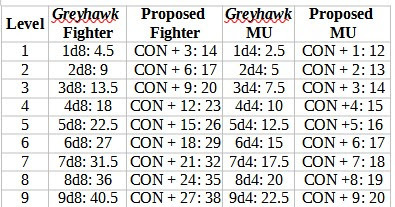 This obviously represents a huge shift in thinking, not simply because of the increased durability of low to mid-level characters, but also because hit point increases are now fixed (+3 per level for formerly d8 hit dice, +2 per level for d6, and +1 per level for d4). This makes a high Constitution an extremely valuable asset, particularly at 1st level. On the other hand, hit points are kept much lower overall. Under Supplement I, a fighter with 18 Constitution and maximum rolls could have almost 100 hit points at 9th level, whereas, under this proposal, a fighter with the same CON would have less than half that.
This obviously represents a huge shift in thinking, not simply because of the increased durability of low to mid-level characters, but also because hit point increases are now fixed (+3 per level for formerly d8 hit dice, +2 per level for d6, and +1 per level for d4). This makes a high Constitution an extremely valuable asset, particularly at 1st level. On the other hand, hit points are kept much lower overall. Under Supplement I, a fighter with 18 Constitution and maximum rolls could have almost 100 hit points at 9th level, whereas, under this proposal, a fighter with the same CON would have less than half that. Naturally, for the proposal to work, there'd have to be a similar shift in the way that monster hit points were calculated, as well as possibly the damage ranges of weapons. Not having tested this, I don't yet have any way of knowing how this would play out or what sorts of unforeseen consequences might emerge from its adoption. At the moment, it's just an idle thought stemming from my desire to see the numerical scores of abilities in OD&D have more meaning beyond being an index on a chart.
Minarian Legends
Between issues #34 (February 1980) and #57 (January 1982) of Dragon magazine, there appeared a series of articles written by Glenn Rahman entitled "Minarian Legends." The series elaborated upon the setting of the Divine Right boardgame published by TSR, with the apparent goal that the setting – called Minaria – might be used for Dungeons & Dragons adventures and campaigns. Interestingly, these consist almost entirely background information, accompanied by wonderful artwork by Kenneth Rahman, rather than any new rules or game mechanics. In any case, the articles are truly delightful and only make me more regretful that I've never been able to locate a copy of Divine Right at anything approaching a reasonable price.
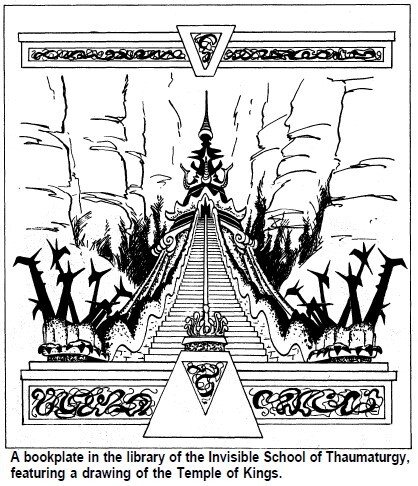
February 6, 2022
Pulp Fantasy Library: The Scarlet Citadel
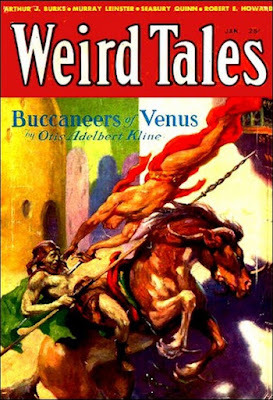 I've never made any secret of my ambivalence toward the 1982 Conan the Barbarian movie of John Milius, even though this is heresy in some quarters. Yet, for all that ambivalence, one of its images, that of an aged Conan, seated upon a throne, after he "became a king by his own hand," endures in my imagination.
I've never made any secret of my ambivalence toward the 1982 Conan the Barbarian movie of John Milius, even though this is heresy in some quarters. Yet, for all that ambivalence, one of its images, that of an aged Conan, seated upon a throne, after he "became a king by his own hand," endures in my imagination. Partly, I think, this is because I find myself wanting to know more about Conan's time as king of Aquilonia. The character's first appearance, in the story "The Phoenix on the Sword," features him as already king and is generally considered one of Robert E. Howard's best tales of the Cimmerian. When I first read the story (which I thought I'd already written about, an oversight I'll have to correct soon), I was really struck by the picture it paints of a middle-aged Conan, forced to deal with political intrigue despite his preference for a straight-up fight. That's a rich vein to be mined for storytelling and I've thought more about the idea than is probably justified.
Besides "The Phoenix on the Sword," Howard wrote another tale of King Conan entitled "The Scarlet Citadel," which appeared in the January 1933 issue of Weird Tales. There are a number of similarities between the two stories, but there are also enough differences to keep them distinct. "The Scarlet Citadel" begins with Conan leading the knights of Aquilonia in battle in neighboring Ophir.
That day Conan, king of Aquilonia, had seen the pick of his chivalry cut to pieces, smashed and hammered to bits, and swept into eternity. With five thousand knights he had crossed the south-eastern border of Aquilonia and ridden into the grassy meadows of Ophir, to find his former ally, King Amalrus of Ophir, drawn up against him with the hosts of Strabonus, king of Koth. Too late had he seen the trap. All that a man might do he had done with his five thousand cavalrymen against the thirty thousand knights, archers and spearmen of the conspirators.
Amalrus, we later learn, had lured Conan into Ophir under the pretext of requesting aid from Conan against Koth, which had supposedly invaded. Ever the loyal ally, Conan rushed to Ophir's aid, apparently never considering the possibility that the call for help was but a stratagem for luring him away from Aquilonia. The mastermind of this plan is "the lean vulture Tsotha-lanti," a sorcerer "clad only in silken robes, his great black eyes glittering from a face that was like that of a bird of prey."
Of this Kothian wizard dark tales were told; tousle-headed women in northern and western villages frightened children with his name, and rebellious slaves were brought to abased submission quicker than by the lash, with the threat of being sold to him. Men said that he had a whole library of dark works bound in skin flayed from living human victims, and that in the nameless pits below the hill whereon his palace sat, he trafficked with the powers of darkness, trading screaming girl slaves for unholy secrets. He was the real ruler of Koth.
How's that for the introduction of a villain? Equally impressive is his first encounter with Conan, after the Aquilonians have been defeated and the Cimmerian is the only one among them left alive.
"I offer you life, Conan," said Tsotha, a cruel mirth bubbling at the back of his voice.
"I give you death, wizard," snarled the king, and backed by iron muscles and ferocious hate the great sword swung in a stroke meant to shear Tsotha's lean torso in half. But even as the hosts cried out, the wizard stepped in, too quick for the eye to follow, and apparently merely laid an open hand on Conan's left forearm, from the ridged muscles of which the mail had been hacked away. The whistling blade veered from its arc and the mailed giant crashed heavily to earth, to lie motionless. Tsotha laughed silently.
"Take him up and fear not; the lion's fangs are drawn."
Tsotha-lanti used a ring with a poisoned needle embedded in its underside to incapacitate Conan. Thus temporarily paralyzed, the Cimmerian is brought to as a prisoner to the titular Scarlet Citadel. There, the three conspirators, including the faithless Amalrus, make plain their intentions.
"Our desires are spoken quickly, king of Aquilonia," said Tsotha. "It is our wish to extend our empire."
"And so you want to swine my kingdom," rasped Conan.
"What are you but an adventurer, seizing the crown to which you had no more claim than any other wandering barbarian?" parried Amalrus. "We are prepared to offer you suitable compensation –"
"Compensation!" It was a gust of deep laughter from Conan's mighty chest.
"The price of infamy and treachery! I am barbarian, so I shall sell my kingdom and its people for life and your filthy gold? Ha! How did you come to your crowns, you and that black-faced pig beside you? Your fathers did the fighting and the suffering and handed their crowns to you on golden platters. What you inherited without lifting a finger – except to poison a few brothers – I fought for.
"You sit on satin and guzzle wine the people sweat for, and talk of divine rights of sovereignty – bah! I climbed out of the abysss of naked barbarians to the throne and in that climb I spilt my blood as freely as I spilt that of others. If either of us has the right to rule men, by Crom, it is I! How have you proved yourselves my superiors?"
It's a terrific exchange, filled with passion and indignation. I have little doubt that Howard poured more than a little of himself into it, with his disdain for the "high and mighty" who looked down on men of modest means such as himself. The anger behind it is palpable and suffuses the rest of the story, as Conan eventually frees himself from captivity and then sets about avenging himself upon those who would steal his throne and immiserate his people.
"The Scarlet Citadel" is a fine pulp fantasy yarn, one that shows off not just the writing skills of Robert E. Howard but also the virtues of Conan as king of Aquilonia. Re-reading it, I found myself once again yearning for more stories of this sort, stories that show the kind of ruler Conan had become and what he was willing to do for the people of Aquilonia, whose lot he had improved by his reign. Even so, "The Scarlet Citadel" is a good read and one I highly recommend. It may well be one of Howard's best tales of Conan.
February 4, 2022
Grognard's Grimoire: Ashalakat
The ashalakat is a 4'-long monstrosity possessing a flat, translucent body and eight strong tentacles. The beast is an aggressive predator that subsists entirely on blood. Its preferred habitat is dark and moist, such as the middle reaches of the Vaults beneath Nalu Hesh.
AC 7 [12], HD 5+1** (23hp), Att 8 × tentacles (1d3), 1 × bite (1d3 + blood drain) THAC0 16 [+3], MV 120’ (40’), SV D12 V13 P14 B15 S16 (2), ML 9, XP 575, NA 1d4 (1d4), TT B
Blood drain: Attaches to victim on a successful hit, doing 1d4 automatic damage per round.Detaching: Must be killed.If victim dies: Detaches and finds a dark place to digest.Constriction: Tentacles grab and constrict after a hit. 1d3 automatic damage per round. Severing tentacles: Requires a hit that inflicts 4 or more damage.Cling: Can move along walls and ceilings.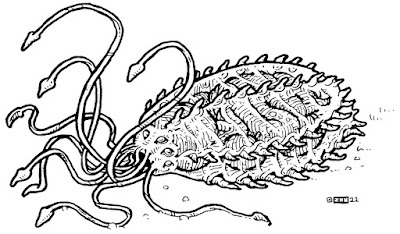 An ashalakat by Zhu Bajiee
An ashalakat by Zhu Bajiee
Go For It!
Here's an advertisement for Boot Hill I'd never seen before. It appeared in issue #40 of Dragon (August 1980).

James Maliszewski's Blog
- James Maliszewski's profile
- 3 followers



